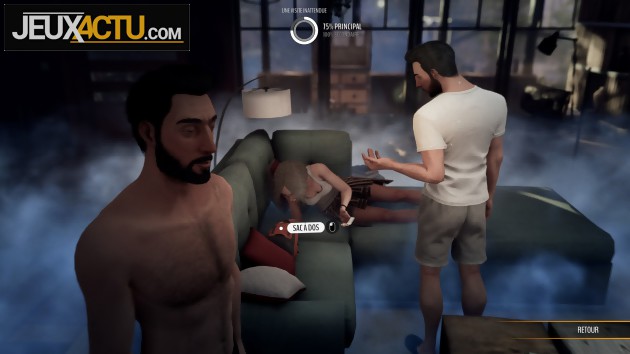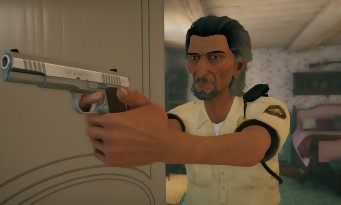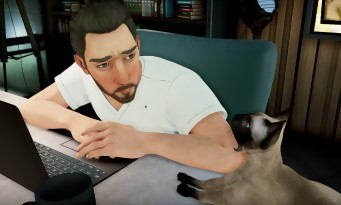The test
Spanish studio founded in 1994 and specializing in adventure games, Pendulo had its heyday in the 2000s thanks to the Runaway saga. In the 2010s, Yesterday and Yesterday Origins also convinced us. We are therefore fully confident that we launched Vertigo, freely adapted from the cult film by Alfred Hitchcok. But let's not try to maintain an illusory suspense and announce it straight away: the result does not really live up to our expectations.
First of all, it seems important to us to clarify a crucial point: despite appearances, its official character, and whatever the developers say about it and the press releases, this Vertigo game is in no way an adaptation of the eponymous film by 'Alfred Hitchcok, better known to French speakers as Sueurs froides. The time, the characters and the scenario are totally different, and only a few “meta” winks link the feature film to the game. Thus, one of the characters watches Cold Sweats in a movie theater at the start of the adventure. , and later talks about it as his favorite film in an innocuous dialogue. As for the fact that the cinematographic hero and his video game successor both suffer from vertigo, this is also a simple reference. Determining in the 1958 work, this phobia does not play the same role here and turns out to be much more anecdotal. The Hitchcockian aspect of the game comes mainly from the general atmosphere, which is also reminiscent of the Twin Peaks series or Alan Wake. Besides, the main protagonist here is also a very troubled writer. The introductory sequence indeed introduces us to Ed Miller who wakes up near a bridge, notices that his car has fallen into the ravine, deduces that his wife and daughter are dead, then sees his own father throw himself from the bridge. . Problem: His father is already dead years ago, absolutely no bodies are found in the wreckage of the vehicle, and Ed is well known to be a hardened bachelor for years. This is something to call into question the mental health of our hero, who will have to collaborate with the psychotherapist Julia Lomas in order to disentangle the true from the false, put his memories in order, and clarify multiple areas of shadow. The two characters are also playable according to the sequences, as well as Sheriff Reyes who is investigating the accident.

VERTIGE OF DESAMOUR
 If this multiplicity of points of view serves the scenario, it has on the other hand almost no influence on the gameplay, which remains minimal in all cases. A few trips to relatively closed places, a few objects to observe here and there, a few choices of dialogues that too rarely have real consequences, and voila! Without forgetting the essential “Quick Time Events” à la Quantic Dream or Dontnod Entertainment, like hammering A or making arcs with a stick to simulate the action presented on the screen. These true-false interactions are all the more disappointing as the fact of succeeding or failing them is most often of no importance. It's just about stimulating the player in the most basic way possible. This point is all the more problematic as the game suffers from many lengths, and often fails to be entertaining. Some actions are simply off-putting, like this passage where we play Ed Miller as a child and where we have to store the groceries! Putting paper towels in a shed, putting vegetables in the fridge and placing bread on a table using basic QTE is obviously nothing short of exciting or interesting. The developers, however, almost had a flash of genius by allowing us to practice hypnosis sessions on Ed. The idea is as follows: relive certain altered memories previously evoked by the hero, and detect inconsistencies in order to restore the truth.
If this multiplicity of points of view serves the scenario, it has on the other hand almost no influence on the gameplay, which remains minimal in all cases. A few trips to relatively closed places, a few objects to observe here and there, a few choices of dialogues that too rarely have real consequences, and voila! Without forgetting the essential “Quick Time Events” à la Quantic Dream or Dontnod Entertainment, like hammering A or making arcs with a stick to simulate the action presented on the screen. These true-false interactions are all the more disappointing as the fact of succeeding or failing them is most often of no importance. It's just about stimulating the player in the most basic way possible. This point is all the more problematic as the game suffers from many lengths, and often fails to be entertaining. Some actions are simply off-putting, like this passage where we play Ed Miller as a child and where we have to store the groceries! Putting paper towels in a shed, putting vegetables in the fridge and placing bread on a table using basic QTE is obviously nothing short of exciting or interesting. The developers, however, almost had a flash of genius by allowing us to practice hypnosis sessions on Ed. The idea is as follows: relive certain altered memories previously evoked by the hero, and detect inconsistencies in order to restore the truth.

Unfortunately, these phases are extremely linear and never put our brains to work. All you have to do is go to the place on the timeline indicated on the screen (the possibility of rewinding the action or moving forward quickly is therefore in reality useless) and click without thinking on the various interactive zones present. in the scene so that the game quietly unfolds its plot. It is also the intrigue that saves the game from disaster, because the scenario offers us multiple twists and turns, most of which are impossible to see coming (except for the ultimate “plot twist”, but it is not very serious). The artistic direction is also worthy of praise. We find in particular the typical “faces” of Pendulo Studios, which helps to remember the different protagonists and to immediately and unconsciously capture their personality. Moreover, the adventure would have benefited from being presented to us as an animated film rather than as a game. Because it is very difficult to ignore the various playful flaws. Slowdowns (even though absolutely nothing magnificent is displayed on the screen), various and varied bugs (text protruding from the screen, scene suddenly plunged into darkness, character who becomes invisible for a few moments …), and Too many loading screens are responding to the call.

